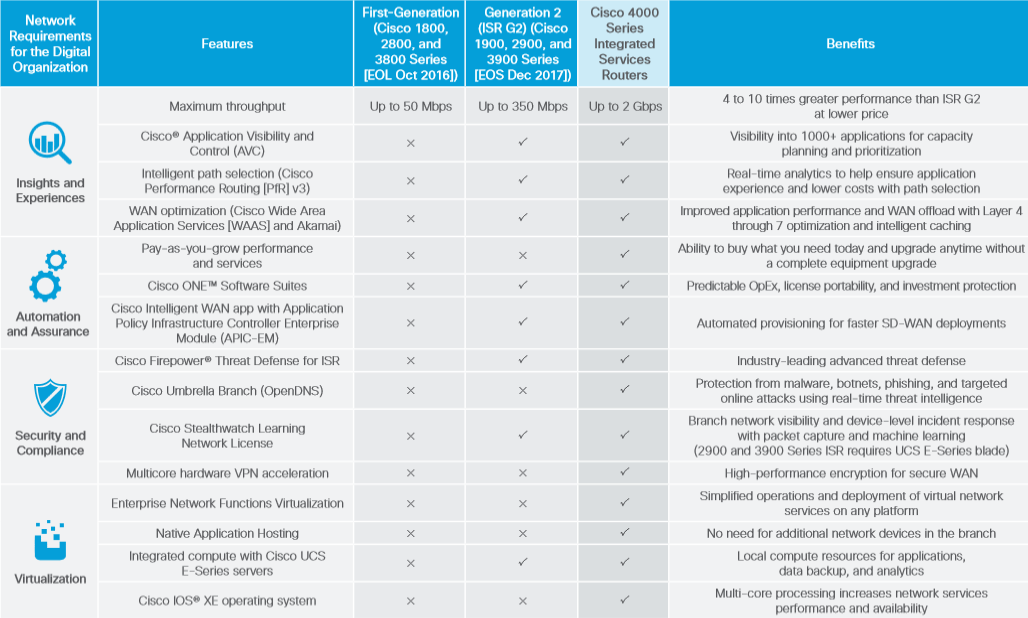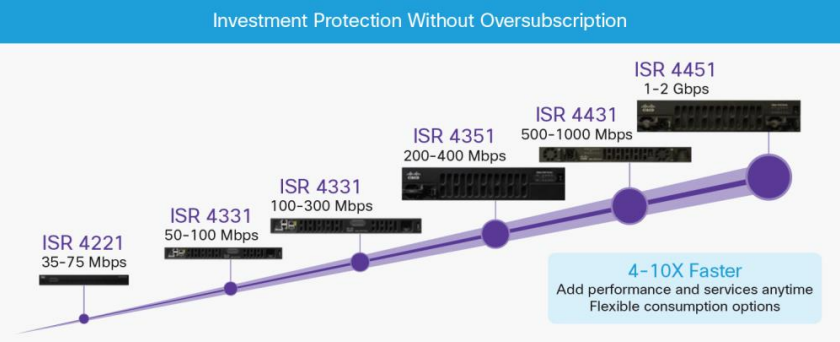
Cisco has updated its Cisco 4000 Series Router Family. The new member-Cisco 4221 ISRs has been added to this popular family.
What benefits does this new 4221 ISRs bring to us? Customers nickname the Cisco ISR 4000 Series as the “Swiss Army Knife” of branch networking. It is praised for its versatility and adaptability all in one box – very much like the pocket utility knife. And the new ISR 4221 is no different: small, but mighty.
Now the Cisco 4000 Series contains six platforms: the 4451, 4431, 4351, 4331, 4321 and the new 4221 ISRs
What’s New on ISR 4421? The ISR 4221 is mightier than the ISR G2, vis-à-vis ISR 1921 and 1941. It is a desktop-like, industrially designed 1RU box priced cost-effectively for mid-markets.
Cisco ISR 4221 Key Highlights:
1. It meets all digital network requirements
You can check the newest Benefits of Migrating to Cisco 4000 Series Integrated Services Routers here:
2. With respect to performance, the ISR 4221 kicks it up a notch with throughput starting at 35 and upgradeable up to 75 Mbps.
3. Despite a 1RU form factor, this economical “Swiss Army Knife” has unmatched values in its class for a few reasons:
- a. It has multi-services support for SD-WAN and is programmable and automated with APIC-EM controller and IWAN app for consistent business-driven and policy-based operations across network domains.
- b. It is an application-aware platform complete with Intelligent Path Control (PfR), application visibility (NBAR2) and Network Contention Control (H/QoS).
- c. It comes with Cisco IOS built-in security features for complete branch threat defense, such as Zone-based Firewall, FirePOWER Threat Defense, Network Address Translation (NAT), and IPSec VPN.
- d. It is a standard-based Linux virtualization platform. With Linux Virtual Container (LXC), signed network service like Snort IPS can be spin up as virtual machine any time.
- e. It is equipped with up to 2×8 integrated switch ports – a true all-in-one platform – for pop-up or micro branches where the average square footage is as little as 350-sf.
- f. It supports IPv6 and legacy WAN connectivity, such as 3G/4G LTE, for IoT use cases such as ATM/Kiosk or industrial environments without dedicated MPLS transport.
For in-depth details, you can check out Model Comparison: ISR 4321 vs. 4331 vs. 4351 vs. 4431 vs. 4451 Router
The new Cisco ISR 4221 is available beginning mid-November. And it will ship with latest Cisco IOS-XE release.
Introducing the Cisco IOS XE Open Service Containers
More about the Cisco 4000 Series ISRs Family
The Cisco 4000 Series is built on a multicore CPU architecture. It runs modular Cisco IOS XE Software, which allows the platform to use to full advantage a distributed multicore architecture. The architecture of the Cisco 4000 Series separates control- and data-plane operations and integrates an industry-first services plane. This design delivers full-featured integrated services up to Layer 7 at high performance, with the ability to deliver application-aware network services while maintaining a stable platform and a high level of performance during periods of heavy network traffic.
The 4000 Series consists of three subseries of routers–the 4400 Series, the 4300 Series, and the 4200 Series.
Cisco 4000 Series ISRs Performance Comparison
Throughout the 4000 Series, all platforms come with fixed maximum performance levels. One fixed base performance level is delivered as the factory default, with an optional performance-on-demand license to increase the base forwarding throughput. This scenario enables deployment in high-speed WAN environments through performance-on-demand licensing to double or, for one of the platforms, triple the router capacity without any hardware upgrades.
All 4000 Series platforms have their fixed performance levels set well within actual capacity, with the result that performance does not necessarily degrade when a service is added to the configuration. This setup provides a deterministic performance, eliminating a network administrator’s guesswork when planning for new services.
OIR (online insertion and removal) is supported on the Cisco 4000 Series (But the Cisco 4221 does not support OIR.) for the following scenarios:
- Surprise insertion or removal of any NIM in any of the NIM slots
- Surprise insertion or removal of any SM-X in the SM-X slots
- Surprise insertion or removal of any power supply or system PoE conversion module
- Surprise replacement of the system fan tray; note, however, that this replacement must take place quickly enough that the system does not overheat, and depending on altitude and ambient temperature, the amount of time can vary greatly
Note that SM-X and NIM modules allow replacement only for like-to-like modules. A faulty module can be replaced with a good module of the same type but cannot be replaced with a completely different module of a different type.
There is only one PVDM slot on the motherboard across the Cisco 4000 Series.
But the ISR 4221 does not have any PVDM slot.
…
Learn more about ISR 4221 via the following resources:
- Nov 8th at 12 noon PT – tune in to Cisco Champion Radio to hear Dax Choksi and Lauren Friedman discuss key highlights about the ISR 4221.
- Nov 10th at 9:30 a.m. local time – at Cisco Live Cancun, catch a new product introduction PSO session (PSOCRS-2221) with Shankarnarayan Dharmarajan and also see a live demo of the new WebUI.
- Cisco.com – for your perusal, view a collection of collaterals about ISR 4221: At-a-Glance, Data Sheet, and FAQ
The main info from https://blogs.cisco.com/enterprise/introducing-new-cisco-dna-ready-platform
More Related Topics about Cisco ISR 4000
Say Something about Cisco 4400 and 4300 Series
Migrating to Cisco 4000 Series ISR…Benefits You Get
Cisco 4000 Series ISR, Top Choice for Today’s Branch Offices





